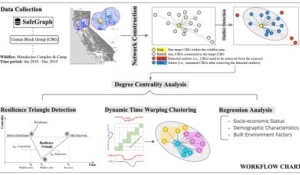Community Resilience to Wildfires: A Network Analysis Approach by Utilizing Human Mobility Data
By: Qingqing Chen (qchen47@buffalo.edu) & Boyu Wang (bwang44@buffalo.edu)
Advisor: Andrew Crooks
Department of Geography
Project Objectives:
•Disasters, such as wildfires, has been a long-standing concern to societies, which often result in significant impacts on the environment, wildlife, and human populations.
•Understanding the impacts and resilience of areas that are often exposed to such events has become essential.
•We propose a novel framework to capture impacts of dynamic disruption of a disaster to assess a community’s resilience to wildfires in a long-term period.
Data and Results
• We utilized a human mobility data collected from SafeGraph between 2018 and 2019 and selected Mendocino Complex and Camp wildfires as test cases.
• Techniques, such as network analysis, resilience triangle detection, dynamic time warping clustering and regression analysis, have been used to quantify resilience of communities at census block group level.
• Results show community resilience can be varied across space, which is highly related to demographic characteristics and socio-economic status.
Significance
• Quantifying community resilience is an open research challenge.
• The study scales up the concepts of resilience to a more empirical framework that can be quantified and visualized.
• We hope the framework proposed here can pave a way to study disasters and their long-term impacts on society.
Publication and Conference Presentation
Chen, Q., Wang, B. and Crooks, A.T. (2023), Community Resilience to Wildfires: A Network Analysis Approach Utilizing Human Mobility Data, The Association of American Geographers (AAG) Annual Meeting, 23rd –27th March, Denver, CO.
Chen, Q., Wang, B. and Crooks, A.T. (2023), Community Resilience to Wildfires: A Network Analysis Approach Utilizing Human Mobility Data, Applied Geography (Under review)

Figure 1. An overview of the research workflow.

Figure 2. Quantified resilience of different CBG clusters in Mendocino Complex and Camp wildfires.